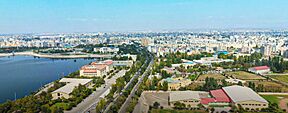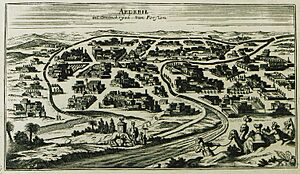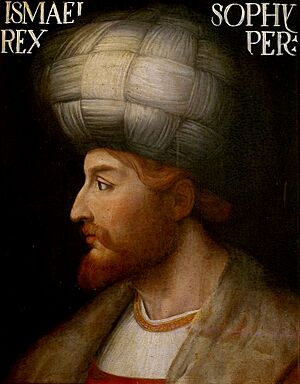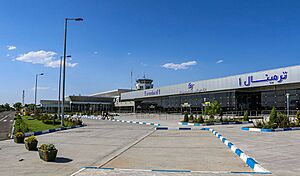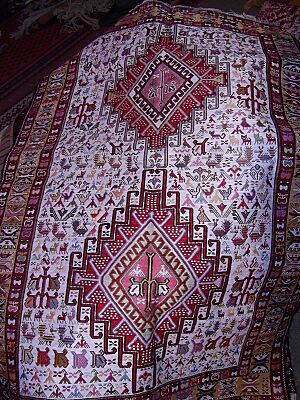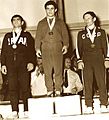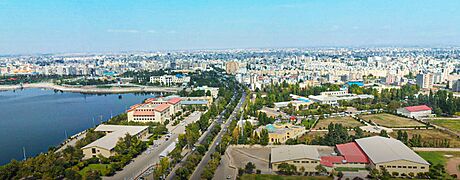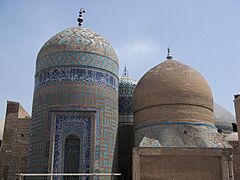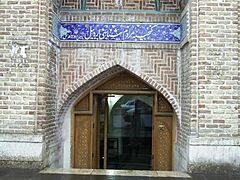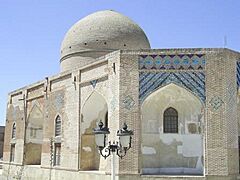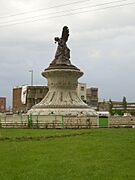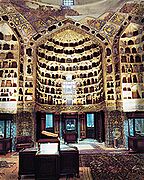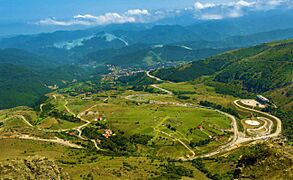Ardabil facts for kids
Quick facts for kids
Ardabil
اردبیل
|
||
|---|---|---|
|
City
|
||
|
Skyline of the city, Sheikh Safi al-Din Khānegāh and Shrine Ensemble, Statue of Shah Ismail I, Tomb of Shaykh Aminuddin Gabriel, Shorabil Lake, Haft Cheshmeh Bridge, Ardabil Bazaar
|
||
|
||
| Nickname(s):
دارالملک، دارالامان
|
||
| Country | Iran | |
| Region | 3 | |
| Province | Ardabil | |
| County | Ardabil | |
| District | Central | |
| Area | ||
| • Total | 18.011 km2 (6.954 sq mi) | |
| Elevation | 1,351 m (4,432 ft) | |
| Population
(2016)
|
||
| • Total | 529,374 | |
| • Density | 29,391.7/km2 (76,124.2/sq mi) | |
| • Rank | 16th in Iran | |
| Demonym(s) | Ardabili | |
| Time zone | UTC+3:30 (IRST) | |
| Postal code |
56131-56491
|
|
| Area code(s) | (+98) 45 | |
Ardabil (Persian: اردبیل; , Azer: Ərdəbil) is a city in northwestern Iran. It is the capital of Ardabil Province. The main language spoken here is Azerbaijani, though Persian is the official language of Iran.
As of 2022, Ardabil had about 588,000 people. The wider Ardabil County has around 650,000 residents. Most people in the area are Shia Muslim.
Ardabil is famous for its trade in silk and carpets. The beautiful Ardabil rugs are well-known around the world. The city is also home to a UNESCO World Heritage Site. This is the Sheikh Safi al-Din Khānegāh and Shrine Ensemble, which includes the tomb of Shaikh Safî ad-Dîn. It also holds the tomb of Ismail I, who founded the Safavid Empire.
Contents
What's in a Name?
The name Ardabil comes from an old word, artavil or artawila. This word means "holy place".
A Look Back in Time
Ardabil has a long and interesting history. Some historians believe it was founded by the Sasanian King Peroz I (who ruled from 459 to 484 AD). He might have named it Shad Peroz.
Because Ardabil is close to the Caucasus mountains, it was often attacked. In 730–731 AD, the Khazars attacked the city. They even went as far as other parts of Iran before being pushed back. An old geographer named al-Maqdisi once said that "seventy languages" were spoken around Ardabil. This probably meant many different forms of the local Adhari language.
In 1209, forces from Georgia attacked Ardabil. They reportedly killed 12,000 people. Later, Ardabil survived two attacks by the Mongols. But in 1220, the Mongols finally took over the city. Even after this, Ardabil managed to grow and become even better than before.
A very important person, Ismail I, was born in Ardabil. He started his plan to unite Iran from here. In 1501, he made Tabriz his capital city. But Ardabil still remained an important place for politics and trade. Because it was near the border, the city was often attacked by the Ottomans between 1514 and 1722. It was also attacked in 1915 during World War I.
During the early Qajar period, the crown prince Abbas Mirza was the governor of Ardabil. He ordered the city to be made stronger with walls. This was because the Russians had attacked Ardabil before. In the next war (1826–28), Russian troops took over the city for a short time. They also took Ardabil's large and famous library to St. Petersburg. They promised to return the books, but they never did.
After these wars, Iran gave up some land to Russia. Ardabil then became very important for trade. It was only 40 kilometers from the new border. European goods came into Iran through Ardabil from Russia. A German diplomat visited in 1872 and saw how busy the city's market was. He also noted many foreigners there.
People and Languages
Who Lives Here?
Most people in Ardabil are Iranian Azerbaijanis. The main language they speak is Azerbaijani.
How Many People?
- In 2006, Ardabil had 412,669 people.
- In 2011, the population grew to 482,632 people.
- By 2016, the city had 529,374 residents.
Where is Ardabil?
Ardabil is located on the Baliqly Chay River. It is about 70 kilometers (43 miles) from the Caspian Sea. It is also about 210 kilometers (130 miles) from the city of Tabriz. The city is about 1,351 meters (4,432 feet) above sea level.
Ardabil is on a flat plain, east of Mount Sabalan. This mountain is 4,811 meters (15,784 feet) tall. Because of its location, Ardabil can have cold weather even in late spring.
Weather in Ardabil
Ardabil has a cold climate. Summers are warm and very dry. Winters are long, cold, and snowy. Many tourists visit Ardabil in the summer because of its cool weather. The coldest temperature ever recorded was -33.8 °C (-28.8 °F). The city gets about 300 mm (12 inches) of rain each year.
| Climate data for Ardabil (1991–2020, records 1976–2020) | |||||||||||||
|---|---|---|---|---|---|---|---|---|---|---|---|---|---|
| Month | Jan | Feb | Mar | Apr | May | Jun | Jul | Aug | Sep | Oct | Nov | Dec | Year |
| Record high °C (°F) | 18.2 (64.8) |
20.0 (68.0) |
27.2 (81.0) |
32.0 (89.6) |
34.2 (93.6) |
38.2 (100.8) |
40.2 (104.4) |
40.4 (104.7) |
37.4 (99.3) |
30.8 (87.4) |
25.0 (77.0) |
21.2 (70.2) |
40.4 (104.7) |
| Mean daily maximum °C (°F) | 4.0 (39.2) |
5.6 (42.1) |
10.9 (51.6) |
16.4 (61.5) |
21.0 (69.8) |
24.0 (75.2) |
25.4 (77.7) |
25.7 (78.3) |
22.8 (73.0) |
18.5 (65.3) |
11.4 (52.5) |
6.3 (43.3) |
16.0 (60.8) |
| Daily mean °C (°F) | −1.2 (29.8) |
0.1 (32.2) |
4.4 (39.9) |
9.2 (48.6) |
13.6 (56.5) |
16.9 (62.4) |
18.8 (65.8) |
18.7 (65.7) |
15.4 (59.7) |
11.2 (52.2) |
5.2 (41.4) |
0.8 (33.4) |
9.4 (49.0) |
| Mean daily minimum °C (°F) | −6.1 (21.0) |
−4.7 (23.5) |
−1.0 (30.2) |
3.2 (37.8) |
7.1 (44.8) |
9.9 (49.8) |
12.4 (54.3) |
12.2 (54.0) |
9.5 (49.1) |
5.7 (42.3) |
0.4 (32.7) |
−4 (25) |
3.7 (38.7) |
| Record low °C (°F) | −31.4 (−24.5) |
−33.8 (−28.8) |
−28.8 (−19.8) |
−14.4 (6.1) |
−8.5 (16.7) |
−0.2 (31.6) |
3.0 (37.4) |
2.2 (36.0) |
−4.4 (24.1) |
−21.0 (−5.8) |
−24.2 (−11.6) |
−27.0 (−16.6) |
−33.8 (−28.8) |
| Average precipitation mm (inches) | 21.2 (0.83) |
24.4 (0.96) |
35.0 (1.38) |
38.9 (1.53) |
39.0 (1.54) |
15.8 (0.62) |
7.0 (0.28) |
5.5 (0.22) |
9.8 (0.39) |
29.1 (1.15) |
34.2 (1.35) |
21.1 (0.83) |
281 (11.08) |
| Average precipitation days (≥ 1.0 mm) | 5 | 4.9 | 6.4 | 7.6 | 7.8 | 3.5 | 1.6 | 1.2 | 1.9 | 3.9 | 4.8 | 4.4 | 53 |
| Average snowy days | 6.7 | 6.7 | 6.8 | 2 | 0.3 | 0 | 0 | 0 | 0 | 0.6 | 3 | 5.4 | 31.5 |
| Average relative humidity (%) | 75 | 75 | 72 | 71 | 71 | 70 | 69 | 70 | 77 | 75 | 76 | 75 | 73 |
| Average dew point °C (°F) | −5.7 (21.7) |
−4.4 (24.1) |
−1.2 (29.8) |
3.1 (37.6) |
7.5 (45.5) |
10.6 (51.1) |
12.4 (54.3) |
12.3 (54.1) |
10.5 (50.9) |
6.0 (42.8) |
0.5 (32.9) |
−3.8 (25.2) |
4.0 (39.2) |
| Mean monthly sunshine hours | 158 | 157 | 175 | 187 | 248 | 297 | 310 | 292 | 233 | 194 | 152 | 152 | 2,555 |
| Source 1: NOAA NCEI, (Snow and Seet days1981-2010) | |||||||||||||
| Source 2: IRIMO(records) | |||||||||||||
| Climate data for Ardabil (1976–2010, records 1976–2020) | |||||||||||||
|---|---|---|---|---|---|---|---|---|---|---|---|---|---|
| Month | Jan | Feb | Mar | Apr | May | Jun | Jul | Aug | Sep | Oct | Nov | Dec | Year |
| Record high °C (°F) | 18.2 (64.8) |
20.0 (68.0) |
27.2 (81.0) |
32.0 (89.6) |
34.2 (93.6) |
38.2 (100.8) |
40.2 (104.4) |
40.4 (104.7) |
37.4 (99.3) |
30.8 (87.4) |
25.0 (77.0) |
21.2 (70.2) |
40.4 (104.7) |
| Mean daily maximum °C (°F) | 3.0 (37.4) |
4.9 (40.8) |
9.8 (49.6) |
16.6 (61.9) |
19.9 (67.8) |
23.4 (74.1) |
25.1 (77.2) |
25.1 (77.2) |
22.7 (72.9) |
17.7 (63.9) |
11.6 (52.9) |
5.9 (42.6) |
15.5 (59.9) |
| Daily mean °C (°F) | −2.4 (27.7) |
−0.5 (31.1) |
3.9 (39.0) |
9.7 (49.5) |
13.1 (55.6) |
16.3 (61.3) |
18.4 (65.1) |
18.4 (65.1) |
15.8 (60.4) |
11.4 (52.5) |
5.9 (42.6) |
0.7 (33.3) |
9.2 (48.6) |
| Mean daily minimum °C (°F) | −7.8 (18.0) |
−5.8 (21.6) |
−2.0 (28.4) |
2.9 (37.2) |
6.2 (43.2) |
9.2 (48.6) |
11.7 (53.1) |
11.7 (53.1) |
8.9 (48.0) |
5.1 (41.2) |
0.3 (32.5) |
−4.5 (23.9) |
3.0 (37.4) |
| Record low °C (°F) | −31.4 (−24.5) |
−33.8 (−28.8) |
−28.8 (−19.8) |
−14.4 (6.1) |
−8.5 (16.7) |
−0.2 (31.6) |
3.0 (37.4) |
2.2 (36.0) |
−4.4 (24.1) |
−21.0 (−5.8) |
−24.2 (−11.6) |
−27.0 (−16.6) |
−33.8 (−28.8) |
| Average precipitation mm (inches) | 23.3 (0.92) |
22.1 (0.87) |
36.1 (1.42) |
40.0 (1.57) |
42.6 (1.68) |
18.9 (0.74) |
5.9 (0.23) |
5.5 (0.22) |
10.4 (0.41) |
31.8 (1.25) |
34.5 (1.36) |
24.4 (0.96) |
295.5 (11.63) |
| Average rainy days | 8.2 | 8.9 | 11.3 | 12.2 | 13.7 | 7.2 | 3.9 | 4.1 | 6.4 | 9.2 | 7.7 | 7.9 | 100.7 |
| Average snowy days | 7.6 | 7.7 | 7.1 | 2.1 | 0.3 | 0.0 | 0.0 | 0.0 | 0.0 | 0.9 | 3.5 | 6.3 | 35.5 |
| Average relative humidity (%) | 75 | 74 | 73 | 68 | 71 | 71 | 69 | 70 | 74 | 75 | 74 | 74 | 72 |
| Mean monthly sunshine hours | 146.2 | 153.7 | 170.4 | 184.9 | 245.4 | 293.6 | 302.8 | 274.3 | 227.1 | 185.6 | 153.4 | 141.0 | 2,478.4 |
Natural Wonders
The Ardabil area has many hot springs and beautiful natural places. These attract tourists. The mineral springs, like those in Sar'eyn, are known in Iran for their healing powers.
There are also several lakes in the area. The biggest ones are Ne'or and Shorabil. These lakes are home to different kinds of water birds. Lake Ne'or is in a mountainous area, about 48 km (30 miles) southeast of Ardabil. It is fed by springs and is about 3 meters (10 feet) deep.
Ardabil's Economy
Ardabil's economy relies on farming, tourism, and some industries.
In 2006, the Iranian government planned to build a very large textile factory in Ardabil.
The Arta Industrial Group (AIG) has one of Iran's biggest textile companies here. This group has won many awards for being a top exporter. It was the first company in Iran to make high-density fiberboard (HDF) and laminate flooring.
AIG also has the first private industrial area in Iran, located in Ardabil. This area covers 100 hectares (about 247 acres) and has fifteen main factories.
The Famous Shrine
One of Ardabil's main attractions is the shrine of Shaykh Safi al-Din Ardabili. He was a Sufi leader who taught Islamic mystic practices. He died in 1334. After his death, his family became very powerful.
In 1501, one of his family members, Shah Isma'il, became a political leader. He united Iran and made Shi'i Islam the official religion. Shah Isma'il founded the Safavid dynasty, named after Shaykh Safi al-Din.
The Safavid rulers, who governed Iran for a long time, made the Shaykh's shrine a popular place for people to visit.
The Ardabil Carpet
In the late 1530s, Shah Tahmasp, son of Shah Isma'il, made the shrine bigger. Around this time, two special carpets were made for the shrine. These carpets were a matching pair.
One of the carpets has a four-line message woven into it. The first two lines are a poem about the shrine being a safe place: 'Except for thy threshold, there is no refuge for me in all the world. Except for this door there is no resting-place for my head.'
The third line is a signature: 'The work of the slave of the portal, Maqsud Kashani.' Maqsud was likely the person in charge of making the carpets. He called himself a "slave" to show humility. The word "portal" can mean a royal court or a shrine. So, Maqsud might have meant both, as the court supported the shrine.
The fourth line gives the date: 946 in the Muslim calendar. This is the same as 1539–1540 CE.
The Ardabil Carpet and the V&A Museum
The two Ardabil carpets were still in the shrine in 1843. Later, an earthquake damaged the shrine. The carpets were sold, perhaps to help pay for repairs. A company from Manchester, England, bought the damaged carpets. They used parts of one carpet to fix the other. This resulted in one "complete" carpet and one without a border.
In 1892, the larger carpet was put up for sale in London. The famous designer William Morris saw it. He told the museum that the carpet was "perfect" and "beautiful." He urged the museum to buy it. The money was raised, and in March 1893, the museum bought the carpet for £2000.
The second, smaller carpet was sold to an American collector. In 1953, it was given to the Los Angeles County Museum of Art. The Ardabil carpet was displayed on a wall for many years. In 2006, the museum created a special display case. Now, the carpet can be seen on the floor, as it was meant to be. To protect its colors, it is lit for only ten minutes every hour.
Getting Around
Airport
Ardabil has its own airport.
Places to Visit
| Attraction | Description |
|---|---|
| The complex of Sheikh Safi-ad-din Ardabili | This is a World Heritage Site. It includes the tombs of Sheikh Safi and Shah Ismail I. It also has a chinaware house, a mosque, and other buildings. The dome of Sheikh Safi's tomb is called "Allah-Allah" and has eight sides inside. |
| Masjid Jameh | These are the ruins of a very old and important mosque. |
| Mirza Ali Akbar mosque and school | This building complex was built during the Qajar period. |
| Ardabil Bazaar | This old Persian market was built during the Safavid period. It has a main hall with open ceilings, a hammam (public bath), and a small mosque. |
| Ardabil bridges | Ardabil has many old bridges. Some famous ones are Pol-e Gilandeh, Pol-e Nayer, and Pol-e Haft Cheshmeh. Most of them were built during the Safavid era. |
| Lerd tourist village | Lerd is a village known for tourism. You can find local clothes, dairy products, honey, and fruits here. It also has the tomb of Imamzadeh Mohammad and the beautiful Sibieh Khani waterfall. |
| Imamzadeh Saleh mausoleum | This tomb belongs to Imamzadeh Saleh, a descendant of a Shia Imam. It was built 250 years ago. |
| Saint Mary church | This Armenian Orthodox church has a wooden main door and a painted dome. It was built in 1876. |
| Mausoleum of Sheikh Jebra'il | This tomb is located about 2 km (1.2 miles) north of Ardabil. |
| Babadavood anbaran | This is a Friday mosque. |
Many villages around Ardabil also have old monuments and tombs. Ardabil is a very old city, with origins going back 4,000 to 6,000 years. It was once the capital of Azerbaijan province. Its most important time was during the Safavid period.
| Attraction | Description |
|---|---|
| Lake Shorabil | This lake is south of Ardabil. Its surface has a thin white layer of minerals, which are said to help with skin diseases. There is also a fun leisure complex near the lake. |
| Baliqly Chay River | This name means "a river with many fish" in Azerbaijani language. The river starts in the Sabalan Mountains and flows through Ardabil. Many villages are built along this river. It also helps water the farms in the province. |
| Sabalan (Savalan) mountain | Sabalan (Persian: سبلان Sabalân) is a volcano that is not active anymore. It is in northwestern Iran, about 20 miles west of Ardabil. Sabalan is the third highest mountain in Iran. It has a lake at its top. There is also a ski resort (Alvares) and hot springs like those in Sarein. |
Sports in Ardabil
Football
Ardabil has several football (soccer) teams. The most popular one is Shahrdari Ardabil. The city is known for producing great football players, like Ali Daei, who was a famous forward.
Volleyball
Ardabil has hosted international volleyball games. These include the 2017 Asian Men's U23 Volleyball Championship and parts of the 2018 FIVB Volleyball Men's World Championship qualification.
Colleges and Universities
Ardabil is home to several universities:
- Mohaghegh Ardabili University
- Ardabil University of Medical Sciences
- Islamic Azad University of Ardabil
- Payam Noor University of Ardabil
- Soureh University of Ardabil
- University of Applied Science of Ardabil
- Islamic Azad University of Khalkhal
Famous People from Ardabil
For a complete list see: Category:People from Ardabil
-
Ismail I, who started the Safavid Empire.
-
Lotfi A. Zadeh, a famous mathematician and computer scientist.
-
Rahim Aliabadi, a former Iranian wrestler who won a silver medal in the 1972 Summer Olympics.
-
Ali Daei, a famous soccer coach and former player.
-
Hossein Rezazadeh, a former Olympic weightlifter who won two gold medals.
-
Naser Cheshmazar, a musician, composer, and arranger.
-
Karim Ansarifard, an Iranian football player.
-
Abdul-Karim Mousavi Ardebili, an Iranian politician and religious leader.
Sister Cities
Ardabil has "sister city" relationships with:
Photo gallery
See also
 In Spanish: Ardebil para niños
In Spanish: Ardebil para niños


